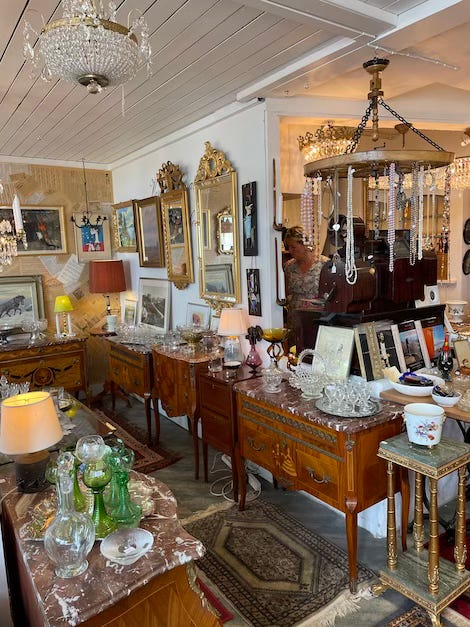An aqueduct, a castle and a broquant
Quote of the week
If you have built castles in the air, your work need not be lost; that is where they should be. Now put the foundations under them.
- Henry David Thoreau
We are now on the way down south in Europe, but before telling you about this trip there are a few more interesting visits from the trip in Sweden.
Håverud’s aqueduct
We continued around lake Vänern and set course for Håveruds aqueduct. According to the tourist information most aqueducts in the world are constructed with Roman stone arches or with cast iron troughs as superstructures. In Håverud, thanks to the daring idea of the well-reputed canal and railway constructor Nils Ericson, Håverud chose another solution. Furthermore, the site is even more impressive thanks to the fact that both a rail and a road bridge pass over the aqueduct.
Once the idea came up during the 19th century to join the Dalsland lakes with a canal the experts realised that the passage in Håverud was considered too difficult due to strong rapids and steep valley walls. Early plans indicated that reloading would be required as well as some kilometres of transport on horse-powered railway to get past the difficult section. Luckily, Nils Ericson was at hand and came up with the following solution. They should build an aqueduct in Håverud, on which boats would be transported over the rapids in a long steel trough. The idea seemed too daring to many, but Ericson had a sound reputation in the construction industry and was an apprentice to Baltzar von Platen himself (the man behind Göta canal). To make a long story short, the end result was a 33.5 metre-long steel trough, joined by 33,000 rivets. The aqueduct, as well as the rest of the Dalsland Canal, was official opened by King Carl XV in 1868. To show the quality of the build, the fact is, that no rivets have needed to be replaced up to this day.
It is an impressive site with the canal, sleuice, the road and railroad above. We were lucky with the rainy day. During our visit the sun came out and we enjoyed walking along the waterway, watching a motor boat go through the sluice and enjoy a magnificent view of the road and railroad from below. Walking around the tourist centre we sat down with a shrimp sandwich and coffee. Went to the car and it started raining again.
Läckö castle
We don’t really have a lot of what you call fairy tale castles in Sweden. Most of them are rather rustic in their appearance. However, there is one castle that fits this description; Läckö castle. Just look at this photo.
Its history goes back to the end of the 13th century when Bishop Brynolf Algotsson, laid the foundation for a fortified castle. It was a much simpler structure in those days and in the 1470s it burnt down. Another bishop expanded the fort. After the Reformation in 1527, King Gustav Vasa took possession of the castle. In 1615, Field Marshal Jacob Pontusson De la Gardie (one of the noblest families at the time) was granted the property. He extended the building in a grand way, even added the third floor. His son, Magnus Gabriel, also initiated major constructions at Läckö. A fourth floor was built and a number of artists were hired to decorated the walls and ceilings. Here is where we find the magnificent King’s Hall. The paintings in this room commemorates Sweden’s successful wars and battles at the time. Later on the castle transferred to other families. However, it is mainly Magnus Gabriel that is connected to the castle. Today it is own by the state and is open as a museum.
An evacuation
We were quietly going around the castle, following the exhibitions from the second floor working ourselves upwards when an alarm was sounding. We had just left the King’s Hall when a guard came running and said we had to evacuate the building. We were rushing down the stairs, out in the courtyard, through the old portal from the 17th century and down the path to the stables, where people had gathered. Nobody seemed to know what had happened. At a point a fire brigade car was there, but nothing serious seemed to have happened. After a while they said we could go inside again.
You can’t help thinking of how many times people living here in the past had to be afraid of attacks. Although, I don’t think this castle in general were in any danger of that kind of thing. We continued our stroll around the exhibitions and gala rooms. The exhibitions are well worth seeing and the rooms, although not that much furnished give you a glimpse of life at the time.
We found a very nice camping next to the castle in the woods. Feeling like you were out camping in the woods, rather than next to a castle. Enjoying our time with a small dinner in the evening and a walk up to the castle the morning after, before heading on to visit our friends Annica and Jerry who were visiting nearby. Friends from Brussels we have not seen for a while, so very nice to meet up again. We stayed over night and were treated with a wonderful fish and seafood dinner.
Limmared
This is a small village south of Borås, famous for their antique and second-hand shops. A map has been produced highlighting the 15 shops, so you can’t miss them. The quality was mixed but about half of them were interesting for us. We did find a few things we bought, a few books among them of course. It is a nice excursion if you are in the vicinity.













